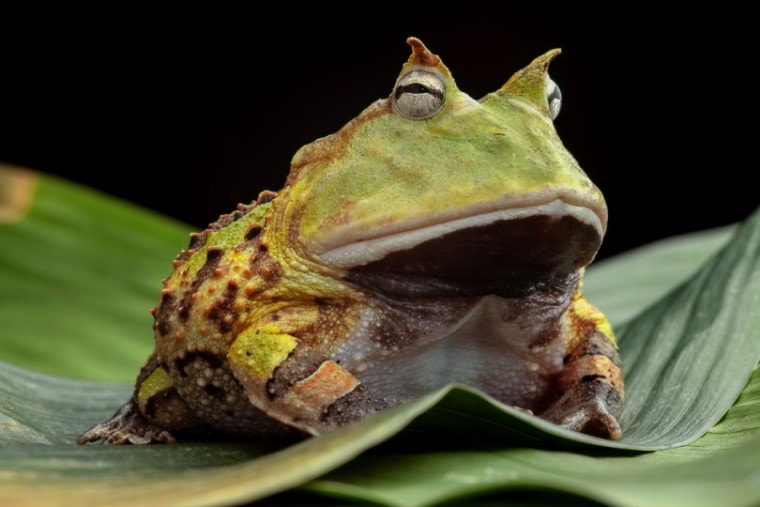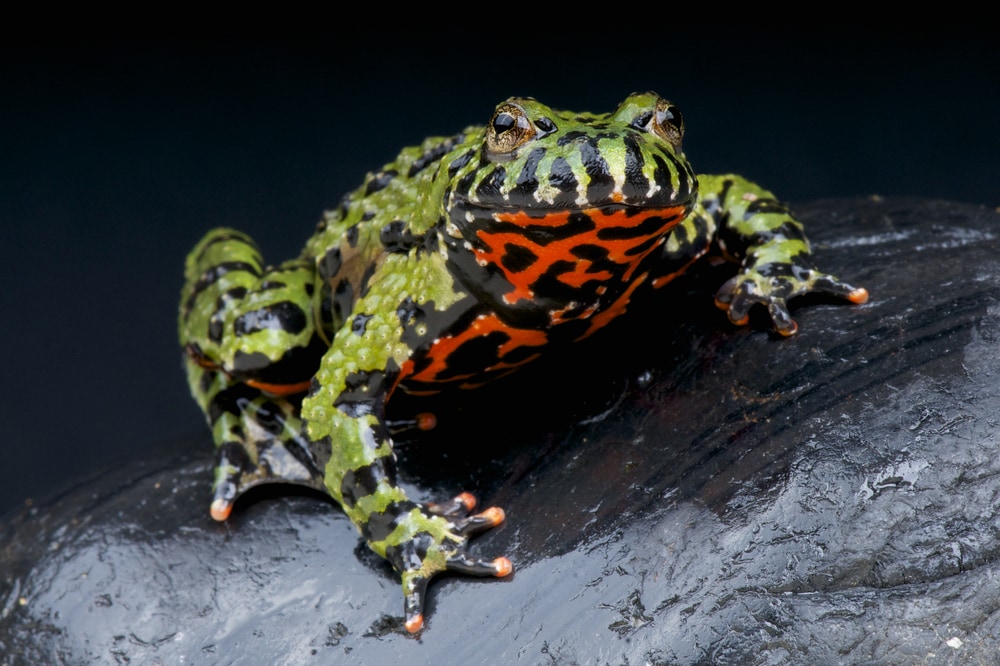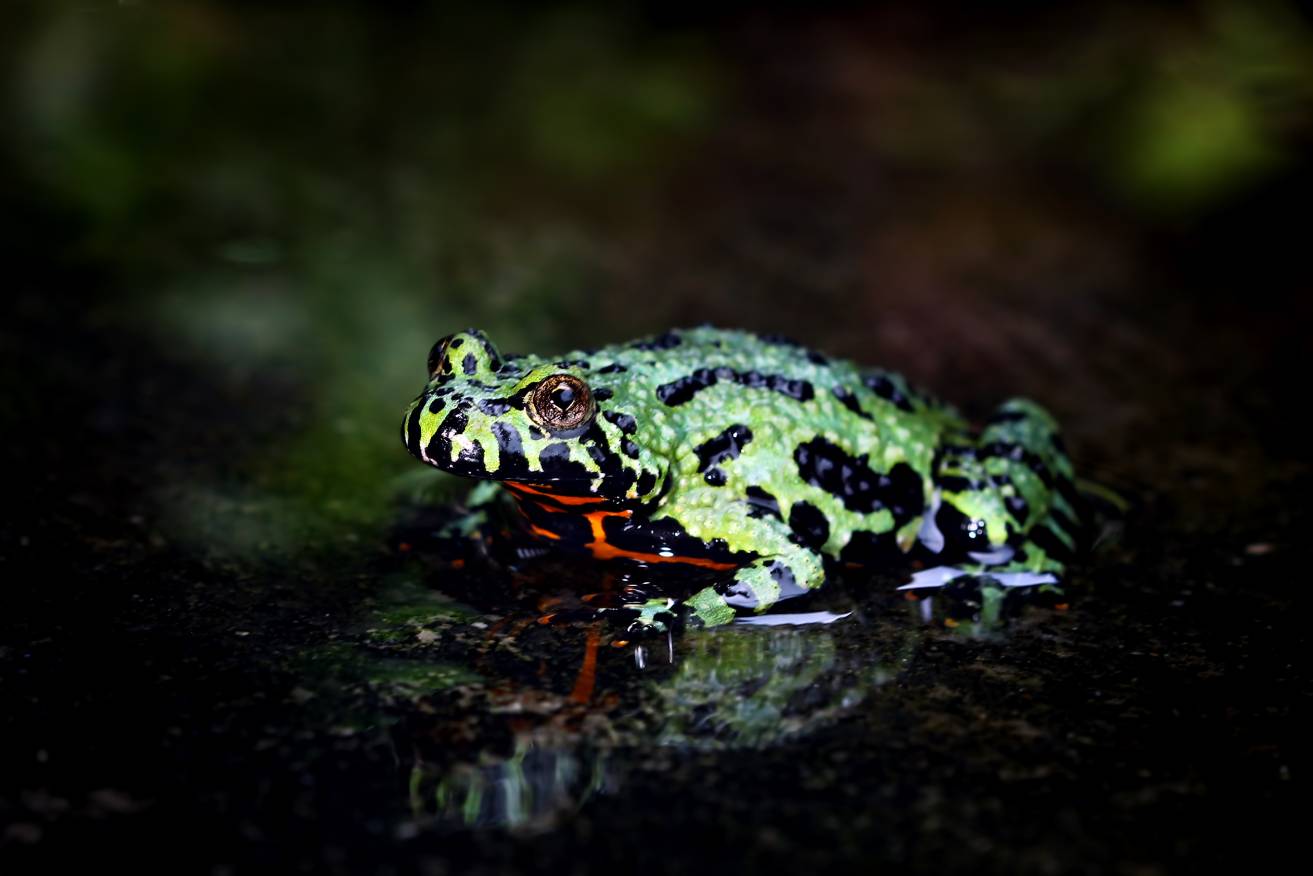
If you’ve ever heard of Pacman, you will instantly understand why frogs from the Ceratophryidae family are called Pacman Frogs. These horned frogs are round, just like the popular video game character. Like Pacman, they will eat just about anything in sight, which makes them easy pets to care for. If you’re a beginner amphibian owner looking for a low-maintenance but interesting pet, the Pacman Frog may be the right fit for you. Read our guide to find out more information about how to care for Pacman Frogs.
Quick Facts about Pacman Frog

| Species Name: | Ceratophrys ornata (Note: there are multiple species in the Ceratophryidae family that are called Pacman Frogs; we will focus on the Ornate Pacman Frog) |
| Family: | Ceratophryidae |
| Care Level: | Low-maintenance |
| Temperature: | 77-83° F (day) 70-75° F (night) |
| Temperament: | Docile |
| Color Form: | Green or tan with brown spots, red accents |
| Lifespan: | 7-10 years |
| Size: | 3-4 inches (males), 7 inches (females); 8-16 oz |
| Diet: | Opportunistic carnivores; they will typically eat ants, mites, snakes, mice, etc. |
| Minimum Tank Size: | 20 gallons |
| Tank Set-Up: | Glass or plastic tank; heating lamp; moss or plants for your frog to hide under |
| Compatibility: | Best to keep frogs separate |
Pacman Frog Overview
The Argentine Horned Frog, or the Ornate Pacman Frog, is a member of the family Ceratophryidae. The eight species of Ceratophryidae are often called Pacman Frogs due to their round shape. They are also commonly called Horned Frogs because of the distinctive horns above their eyes. Perhaps the most distinctive feature of a Pacman Frog is its mouth, which is usually about half as big as the frog itself.
As the name, Argentine Horned Frog suggests, these creatures are native to South America. Their green and brown coloration helps them camouflage themselves when they burrow into the ground, which is useful when potential prey comes along. These frogs are popular pets due to their relatively small size and low care level. Although interesting to look at, Pacman Frogs don’t tolerate being handled very well; not only does excess handling tend to stress them, but they can harm human handlers as they have a tendency to bite. If you’re looking for a pet you can handle, you may want to look elsewhere.

How Much Do Pacman Frogs Cost?
The initial cost of a Pacman Frog will likely be somewhere between $15-$30. When purchasing an amphibian or reptile as a pet, you should also take into account the costs associated with housing and feeding your pet. Your frog’s tank will start at $25, and you can expect to pay another $10-$20 for a heating lamp.
Typical Behavior & Temperament
Pacman Frogs are typically docile in captivity. However, it’s best if you handle these frogs as little as possible; they are often voracious eaters and will try to bite anything that gets close enough to eat.
Appearance
The Ceratophrys ornata is one of eight species of Pacman Frogs that exist in the wild. All eight species look relatively similar: they have the characteristic round body and horns above their eyes. Their coloration typically varies from brown to dark green with brown spots. These frogs change slightly in appearance as they get older.
The Ceratophrys ornata’s square head distinguishes it from other Pacman Frogs. They can have brown or green stripes or spots.
How to Take Care of Pacman Frogs

Habitat, Tank Conditions & Setup
Pacman Frogs like to burrow, so it is important to consider your frog’s substrate. Make sure the substrate is at least 4 inches thick to allow for digging. One of the best options for substrate is coconut fiber, which you can buy in bulk or at your local pet store. Coconut fiber is also a good choice because it retains moisture well, which is important since you need to be able to maintain humidity in your Pacman Frog’s tank. Ideally, the humidity in the tank should be between 70%-80%. Mist your Pacman Frog’s substrate frequently to ensure you retain the proper level of humidity, but be mindful not to over mist; the substrate should not be wet, but damp.
In addition to humidity, you should also consider how you are going to heat your Pacman frog’s tank. The temperature of your frog’s tank should be up to 83° F during the day and can drop to around 70° F in the evening. You should avoid using heaters that are placed under the tank as they can burn your frog, but keep in mind that an overhead light bulb can dry your frog out. The temperature of your frog’s tank should always be warm, but it should never reach the high 80s. Keeping a thermometer in the tank will help you gauge when to make adjustments to the temperature.
Finally, you should provide your Pacman Frog with some plants, moss, or other decor in which to hide. Consider placing some plants around your Pacman Frog’s water dish, as he is likely to spend a lot of time there.
Do Pacman Frogs Get Along with Other Pets?
Generally speaking, Pacman Frogs should not be housed with other amphibians. This is because Pacman Frogs are opportunistic carnivores who will eat anything they can. In particular, you should never try to house a Pacman Frog with a smaller pet—even another frog—because your Pacman Frog will likely try to eat it. If you have another frog that is around the same size as your Pacman, it may be difficult for your Pacman Frog to eat, but it is possible that your pets will still try to fight one another.
What to Feed Your Pacman Frog
As stated, Pacman Frogs are opportunistic carnivores. That means they will eat just about anything, which is good news for you because it makes them relatively easy to care for. You should plan to feed your Pacman Frog crickets, earthworms, and roaches as their primary diet. They can also occasionally eat mealworms, ants, mites, and larger prey such as snakes, baby mice, and even other frogs. If you primarily feed insects to your Pacman Frog, he should eat on a daily basis. However, if you tend to feed him larger prey, you can cut back his feeding schedule to every few days. As with any pet, if you notice that your frog is becoming overweight, you should adjust how much and how often you feed him.
Keeping Your Pacman Frogs Healthy
In addition to the nutrients your frog will get from eating a variety of insects and vertebrates, you should also plan to feed your frog supplements. Frogs in captivity need dietary supplements because they simply can’t get the same level of diversity in their diet that they would get in the wild. In order to give your Pacman Frog supplements, you can simply dust his food with a special supplement formulated for frogs before placing it in his tank. Using a calcium supplement and a multivitamin will help keep your frog’s diet healthy and balanced.
Breeding
It is relatively easy to breed Pacman Frogs. In the wild, Pacman Frogs breed during the rainy season. Therefore, you should simulate the rainy season in your frog’s enclosure.
Before breeding occurs, however, you need to provide your frogs with a period of hibernation. The hibernation period should take place in a cool and dry environment and last about 60 days. To facilitate this hibernation period, place your frogs in tanks with a moss substrate. Maintain a temperature of about 70° F and do not mist the tank.
After this initial hibernation period, move your male and female frogs into a separate tank with shallow water and plants where your female frog can lay eggs. Spray your frogs with water to imitate rain. Your female frog should lay eggs within a matter of days. Once the eggs are laid, return the parent frogs to their own separate tanks. The eggs should hatch in about three days. Once they hatch, you should separate each of the tadpoles into their own tanks to prevent your young Pacman Frogs from eating one another.
Are Pacman Frogs Suitable For You?
Because they will eat just about anything, Pacman Frogs are low-maintenance pets. They are also relatively small frogs that don’t require an abnormally large tank. For these reasons, Pacman Frogs can be great pets for beginners. That being said, you should know that these frogs are not the best animals for handling. They are interesting to look at, but you won’t be doing much more than feeding and looking at your Pacman Frog. You may also want to reconsider getting a Pacman Frog if you already have other reptiles or amphibians that live in tanks and you have limited space; your Pacman Frog will need its own enclosure.
Related Reads:
Featured Image Credit: Dirk Ercken_Shutterstock








